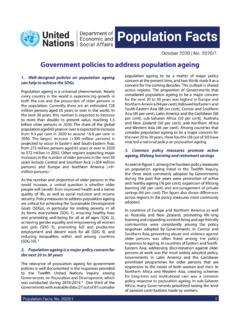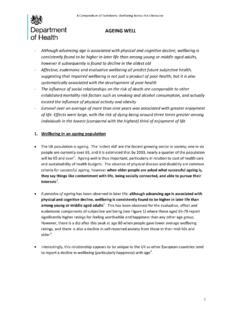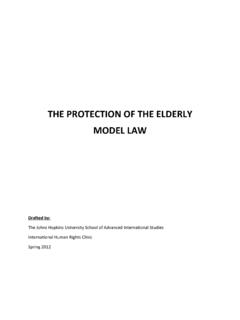Transcription of World Population Ageing 2013 - United Nations
1 E c o no m i c &. S o c i a l A f f a i r s World Population Ageing 2013 . United Nations ST/ Department of Economic and Social Affairs Population Division World Population Ageing 2013 . United Nations New York, 2013 . DESA. The Department of Economic and Social Affairs of the United Nations Secretariat is a vital interface between global policies in the economic, social and environmental spheres and national action. The Department works in three main interlinked areas: (i) it compiles, generates and analyses a wide range of economic, social and environmental data and information on which Member States of the United Nations draw to review common problems and take stock of policy options; (ii) it facilitates the negotiations of Member States in many intergovernmental bodies on joint courses of action to address ongoing or emerging global challenges; and (iii) it advises interested Governments on the ways and means of translating policy frameworks developed in United Nations conferences and summits into programmes at the country level and, through technical assistance, helps build national capacities.
2 Note The designations employed in this report and the material presented in it do not imply the expression of any opinion whatsoever on the part of the Secretariat of the United Nations concerning the legal status of any country, territory, city or area or of its authorities, or concerning the delimitation of its frontiers or boundaries. The term country as used in the text of this publication also refers, as appropriate, to territories or areas. The designations developed and developing countries or areas and more developed , less developed and least developed regions are intended for statistical convenience and do not necessarily express a judgement about the stage reached by a particular country or area in the development process.
3 Suggested Citation: United Nations , Department of Economic and Social Affairs, Population Division ( 2013 ). World Population Ageing 2013 . ST/ ST/ United Nations publication Copyright United Nations , 2013 . All rights reserved Preface The Population Division of the Department of Economic and Social Affairs of the United Nations Secretariat is responsible for providing the international community with up-to-date and objective information on Population and development. The Population Division provides guidance to the United Nations General Assembly, the Economic and Social Council and the Commission on Population and Development on Population and development issues. The Division also undertakes regular studies on Population levels, trends and dynamics, including trends in Population Ageing , changes in Population policies and the interrelationships between Population and development.
4 In the area of Population Ageing , the Population Division prepares national, regional and global estimates and projections of older populations, monitors levels and trends in Population Ageing and collects and analyses information on the relationship between Population Ageing and development. The Population Division also organizes expert group meetings on various aspects of Population Ageing . This report is the fourth in the series World Population Ageing . The first report was released in 2002. in conjunction with the Second World Assembly on Ageing . The present report, which updates the 2007. and 2009 editions, provides a description of global trends in Population Ageing and includes new features on the socio-economic and health aspects of Ageing .
5 This report is accompanied by an interactive database on the Profiles of Ageing 2013 . This report was prepared by a team led by Jorge Bravo, including Hantamalala Rafalimanana and Mun Sim Lai, who carried out research and drafted chapters. Ivan Prlincevic contributed programming and data processing and Donna Culpepper and Neenah Koshy provided formatting and editorial support. John Wilmoth provided key guidance and useful comments on the draft report. The Population Division acknowledges the valuable research inputs provided by Luis Rosero-Bixby and Maliki Achmad. The present report has been issued without formal editing. Responsibility for the World Population Ageing 2013 report rests with the Population Division.
6 This report, as well as the profiles of Ageing and data on older persons, can be accessed on the Population Division's website at Questions and comments concerning this publication should be addressed to the Director, Population Division, Department of Economic and Social Affairs, United Nations Secretariat, New York, NY 10017, by telephone at +1 (212) 963-3209, fax at +1 (212) 963-2147, or e-mail at United Nations Department of Economic and Social Affairs Population Division iii Sources, methods and classifications Data on demographic trends used in the present report are taken from the 2012 Revision of the official United Nations World Population estimates and projections ( United Nations , Department of Economic and Social Affairs, Population Division, 2013 ).
7 In addition, data on labour force participation were obtained from the International Labour Organization (2011) and data on statutory retirement age from the United States Social Security Administration ( 2013 ). Data on living arrangements and marital status were compiled from United Nations (2012). The Population estimates and projections, which are prepared biennially by the Population Division of the Department of Economic and Social Affairs of the United Nations Secretariat, provide the standard and consistent set of Population figures that are used throughout the United Nations system as the basis for activities requiring Population information. In the 2012 Revision of the World Population Prospects, standard demographic techniques were used to estimate the Population by age and sex, as well as trends in total fertility, life expectancy at birth, infant mortality and international migration for the years 1950.
8 Through 2010, from data available from censuses and post-enumeration surveys; demographic and health surveys; Population and vital registration systems; scientific reports and data collections; and from data and estimates provided by international agencies. The resulting estimates provided the basis from which the Population projections follow. In the 2012 Revision, the Population projections are based on a probabilistic (Bayesian) method for projecting total fertility and life expectancy at birth. This method is based on empirical fertility and mortality trends estimated for all countries of the World for the period 1950 to 2010. The present report draws on the medium variant Population projections through the year 1.
9 2050. The countries and areas identified as statistical units by the Statistics Division of the United Nations and covered by the above estimates and projections, are grouped geographically into six major areas: Africa; Asia; Europe; Latin America and the Caribbean; Northern America; and Oceania. Those major areas are further divided geographically into 21 regions. In addition, the regions are summarized, for statistical convenience, into two general groups more developed and less developed on the basis of demographic and socio-economic characteristics. The less developed regions include all regions of Africa, Asia (excluding Japan), Latin America and the Caribbean, and Oceania (excluding Australia and New Zealand).
10 The more developed regions include all other regions plus the three countries excluded from the less developed regions. The group of least developed countries, as defined by the United Nations General Assembly in its resolutions (59/209, 59/210 and 60/33) in 2007, comprises 49 countries. See Annex II for further detail. 1. Further information about data sources and methods underlying the estimates and projections of Population can be found on the Internet at and iv World Population Ageing 2013 . Contents Page iii Sources, methods and classifications .. iv Explanatory ix Executive summary .. xi Introduction .. 1. Chapter I. DEMOGRAPHIC DETERMINANTS AND SPEED OF Population Ageing .. 3. II. THE CHANGING BALANCE AMONG AGE GROUPS.















